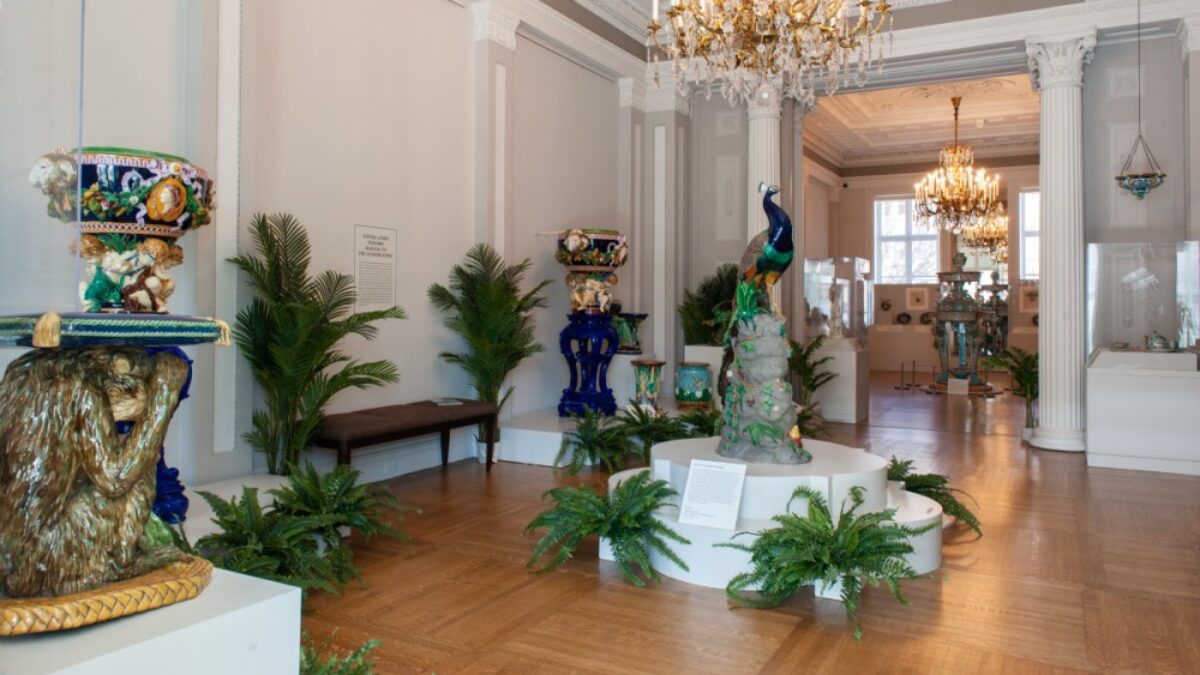My initial reaction on visiting the astonishing “Majolica Mania” at The Walters Art Museum in Baltimore, Maryland was trepidation. I imagined bringing my four-year-old nephew and two-year-old niece, and them wriggling out of my grasp to run rampant through the rooms, squealing with delight at all the colorful ceramic objects featuring birds, mermaids, monkeys, and even the Man in the Moon.
Yet provided that those who make the effort to see this fascinating exhibition keep a close watch on any small humans they may bring, the effort will be well-rewarded. Not only is there a kind of child-like wonder in the pieces, but children are very much part of the story behind these incredible decorative art objects.
The term “majolica” can be a subject of dispute among decorative arts experts, but generally refers to a style of colorful, usually lead-glazed, and elaborately decorated pottery. It became hugely popular in America and Europe from about the middle of the 19th century to the early part of the 20th century.
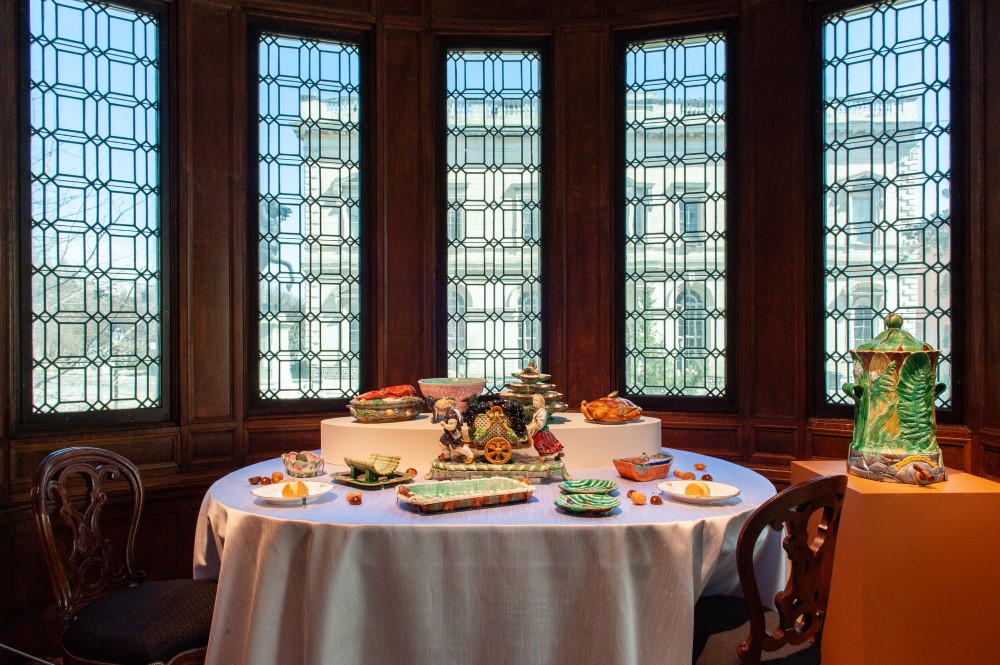
Victorians Adored Majolica
Stylistically, majolica had its origins in Renaissance ceramics, but thanks to the Victorian love of eclecticism and whimsy, these forms were often fused with influences from other cultures, history, and nature, in order to create something novel. Unlike the one-off originals by Renaissance ceramicists such as Bernard Palissy (c. 1510-1589), however, Victorian majolica was an industrial-scale product. Clay molds for items such as urns, bowls, and so on could be reused, and at the height of its popularity the production of these objects was enormous.
The finest manufacturer of majolica was Minton and Co., based in the English pottery town of Stoke-on-Trent. Minton’s had many competitors and imitators throughout England, Europe, and, thanks to immigration, eventually in America. Although some of the showpieces created by Minton and others were of a size and cost only the very well-to-do could manage, most catalog items came within reach of increasing numbers of middle-class consumers.
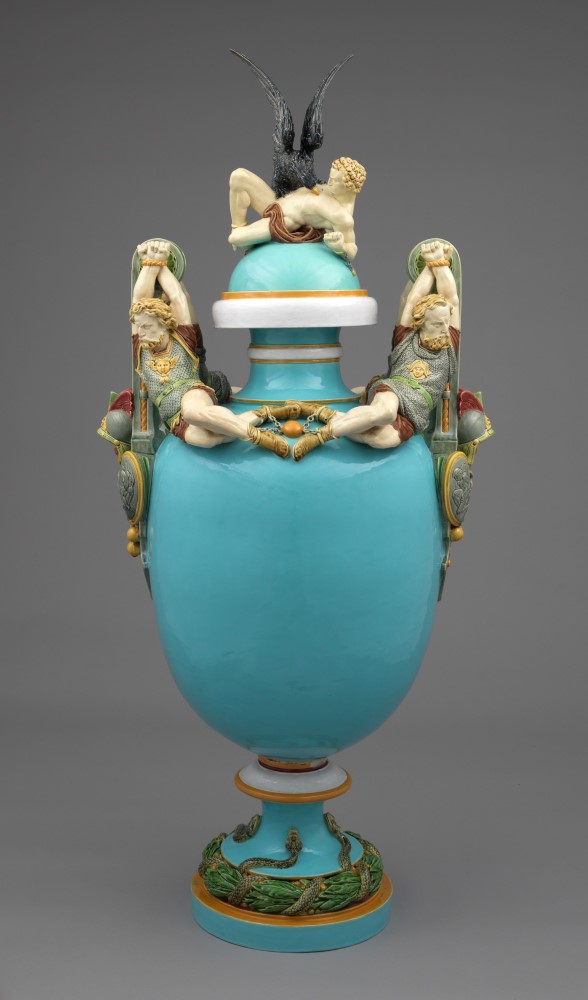
Due to high production costs, the more elaborate, showy examples of majolica were never hugely profitable, despite the attention they received for decades at events such as world’s fairs. At the opposite end of the market, eventually more commonplace majolica items could be found in almost every home, from inexpensive tableware to giveaway premium sugar and tobacco jars.
Victorians’ gradually increasing concern for public hygiene led to a fondness for manufacturing innovations that would allow them to keep things clean more easily. This led not only to the development of indoor plumbing for bathrooms and kitchens, but also a penchant for hygienic materials with practical applications.
In a time before air conditioning and refrigeration, a room—or, in the case of Windsor Castle, an entire dairy—could be lined with majolica tiles to keep it cool and clean, yet attractive. It’s no accident that, here in Washington DC, majolica tiles and fittings by Minton’s and others can be found in public spaces across town, from the Capitol building to the Victorian-era Smithsonian museums.
When Majolica Came To America
America eventually became a significant innovator in majolica in its own right, as the show makes clear with rooms featuring ceramics produced in New Jersey, Pennsylvania, and elsewhere. As immigrant potters arrived in America, many brought majolica molds so they could start their own pottery factories, adapting their designs to American tastes.
Thus, an English majolica milk jug in the show displays a scene of boys playing cricket, while next to it an American version from a few years later shows virtually the same scene, except the mold has been altered slightly to make it a game of baseball. By the turn of the previous century Baltimore-based Edwin Bennett Pottery Company, once the single largest U.S. ceramics manufacturer, was able to manufacture its giant “Fern Stand with Gryphon Support” (1898), well-described by one of the curators as possibly the best single piece of majolica ever made in America.
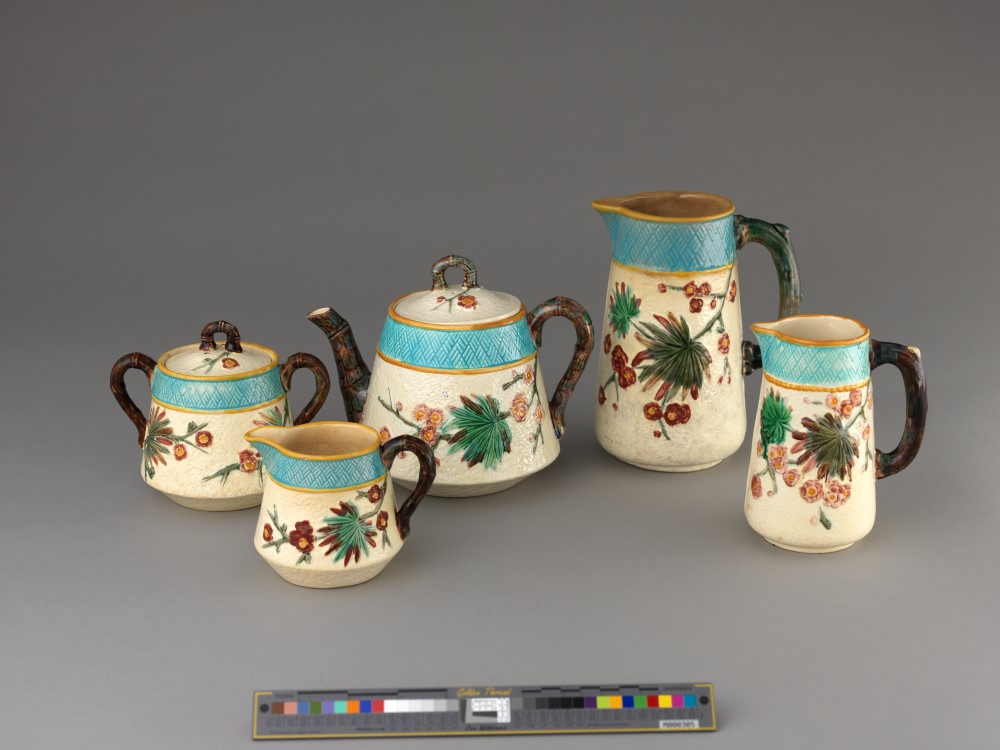
One of the great pleasures of visiting this exhibition is that it takes place in the portion of The Walters known as Hackerman House, a mansion built just a few years before Minton debuted its majolica wares at the legendary Great Exhibition in London in 1851. Most shows today, even in very old and established cultural institutions, are mounted in blank spaces lacking in any kind of architectural detail or interest. Here. however, thanks partly to how the exhibition is staged, one gets a real sense of moving about inside a home where these art objects are not only the latest fashion but also in regular use.
Thus, the home’s former dining room displays majolica dinnerware and serving pieces on the table. A selection of whimsical cheese barrels on a nearby shelf is designed to keep out any hungry mice. A giant punch bowl supported by Punch himself stands in one corner, while vividly decorated oyster plates hang in another.
Meanwhile, in the entrance hall, large-scale vases and urns awaiting floral arrangements stand in niches and visually lead you up the spiral staircase. Hundreds of these objects are spread over two floors of the mansion, and while many are of a more manageable size, plenty of colossal pieces are not just visually stunning, but also technically impressive.
Yes, A Giant Majolica Peacock
Take the giant majolica peacock, for example, affectionately known as “Percy,” who serves as the unofficial mascot of the exhibition. He was manufactured by Minton in 1876. From atop his majolica tree trunk, Percy towers over you in his shimmering, feathered finery. He dominates a room of the mansion staged to resemble a Victorian conservatory, complete with potted plants.
All the more remarkable, considering Percy’s giant size, is that he was cast as a single piece, apart from the tiny crest atop his head. Imagine the skill and sheer bravado needed to attempt making something so gigantic out of clay, not to mention firing it in a kiln and enameling it with lead glazes, all the while hoping nothing will break, crack, or run during that entire complicated process.
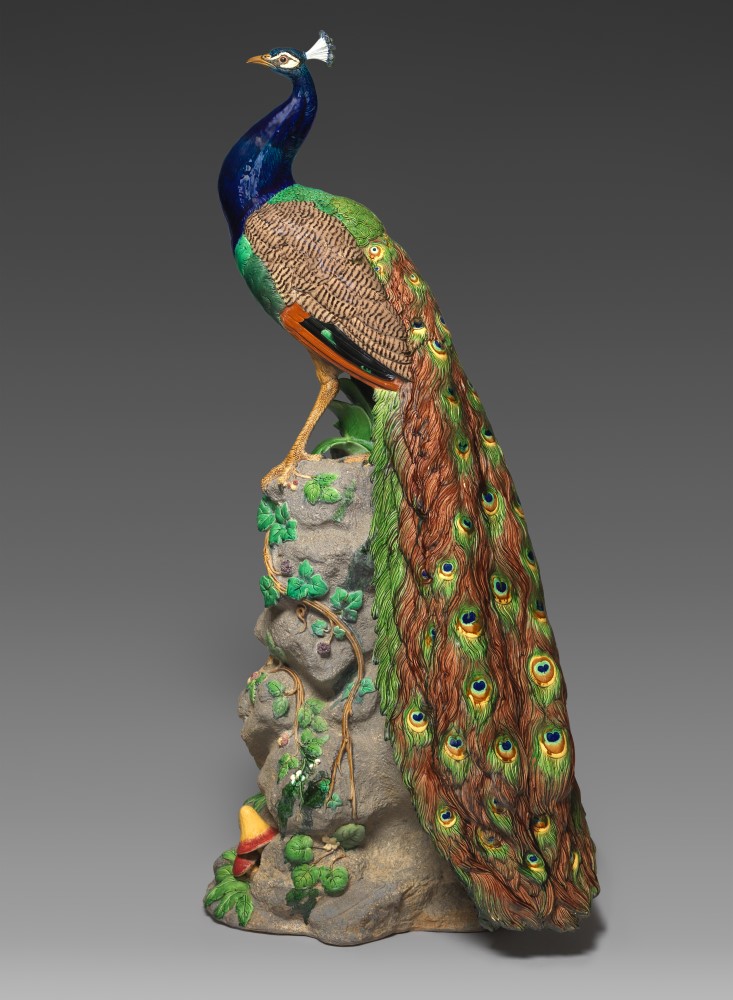
Percy is also a good example of the somewhat strange dichotomy at work here. While the objects often represent or reference things from the natural world, their method of production was decidedly unnatural. It is within this idea of the unnatural that children come back into the story, albeit in a tragic way.
You can’t have majolica without its shiny, reflective surface, which comes from its lead-based glaze. We all know lead exposure can have devastating health consequences. Many majolica pieces were decorated by women, and in order to get a fine point on a paintbrush, for example, these decorators would often moisten the end of the brush in their mouths. As a result, they frequently ingested lead, which went on to poison them or cause birth defects in their unborn children.
Before the enforcement of child labor laws, many children also worked in these pottery factories. Like the adult employees, they would inhale dust and toxic fumes, suffer amputated digits, or possibly even die in a kiln explosion.
Facing the Darkness Inside This Beauty
To its credit, this exhibition doesn’t shy away from sharing these sobering facts, instead providing them as a part of the history of majolica. It invites visitors to go a bit deeper into understanding the implications of the craze for these decorative objects, although without hitting him over the head. That said, perhaps the single most moving piece in the show isn’t a piece of majolica, but something that honors the men, women, and children who labored to create it.
As you reach the top of the stairs in the mansion, a room to your left contains a towering installation of white-glazed ceramics. I uttered a “Wow” as I spotted it. Contemporary American ceramic artist Walter McConnell (1956- ) created a work specifically for this show, composed of crowded tiers of hundreds of white-glazed decorative ceramic pieces.
Most of these are taken from commonplace molds of things such as angels, cartoon characters, vases, and so on. Yet mixed in are beautifully executed ceramics depicting five of the everyday people who worked in the majolica factories, based on contemporary photographs. Titled “A Requiem in White” (2020), McConnell’s piece honors those who suffered and died as a result of the mania documented in this exhibition.
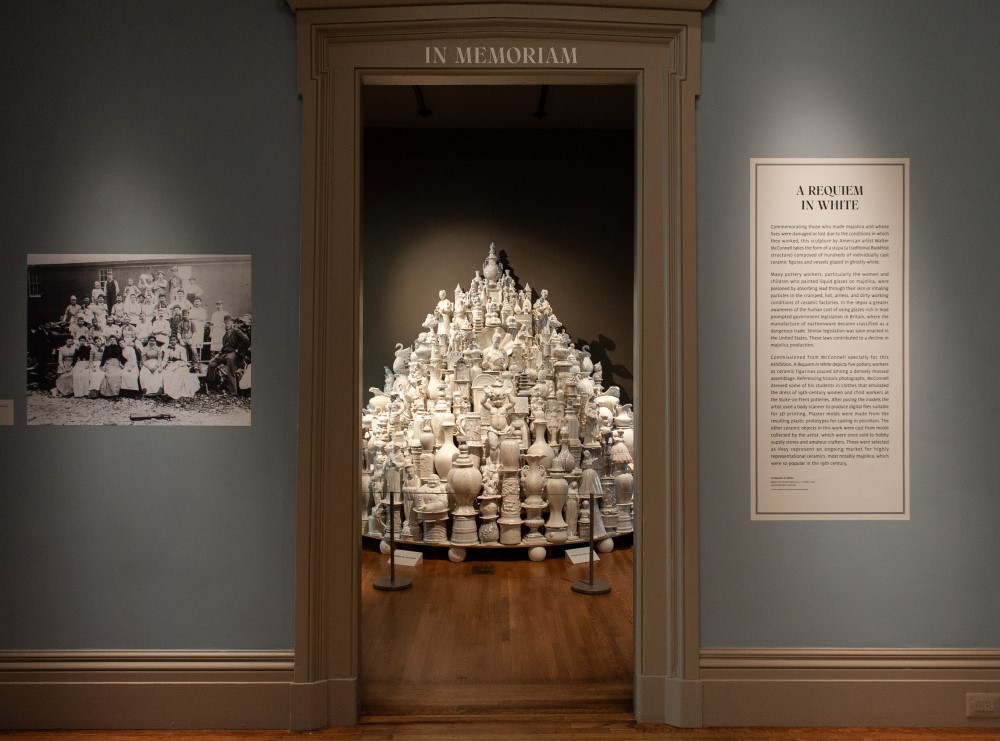
Thus, while the majolica ceramics are unquestionably what draw our eye, this show is equally about those who made these highly decorative, sometimes strange, and often practical decorative objects. They were the collective output of people who came together to do everything from excavating the clay to designing a piece, molding and firing it, decorating it, retailing it, and finally collecting it.
Whereas an exhibition about painting or sculpture tends to focus primarily on the vision of a particular artist or group of artists, here the final product is only one facet of what the visitor observes. To that end, it’s one of the best shows I’ve seen in recent years that covers the whole story of a particular moment in decorative art, not just its more attractive aspects.
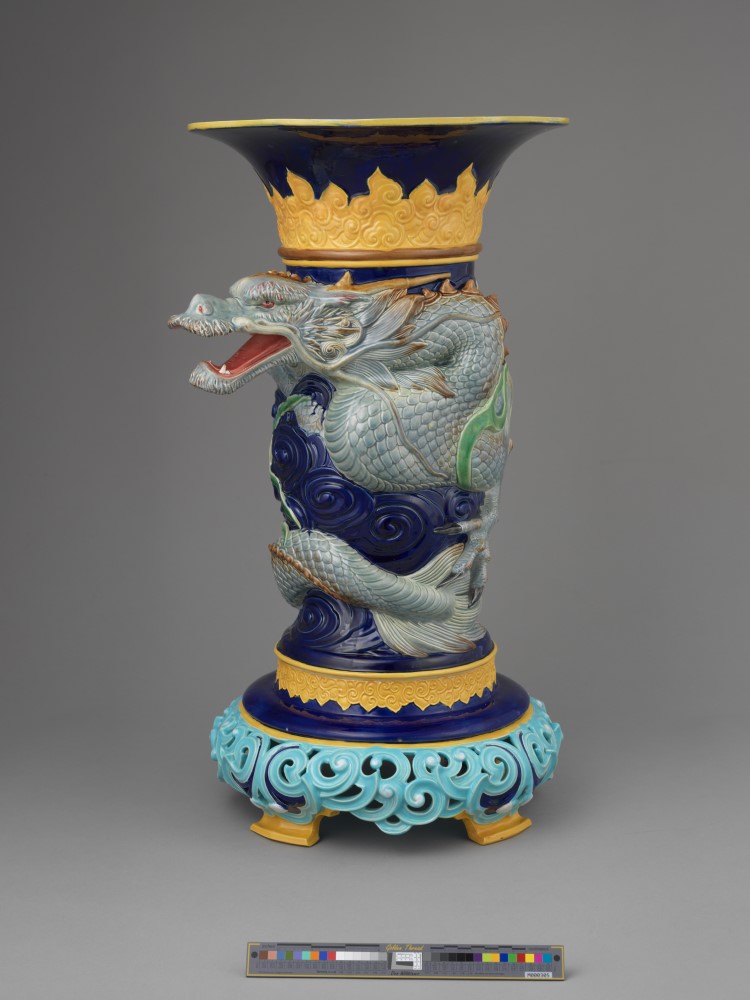
“Majolica Mania” is at The Walters Art Museum in Baltimore through August 7, 2022. Children are indeed welcome here, as evidenced by an activity room set aside for them to learn more about making and decorating majolica.
For those who can’t make it to the exhibition in person, two different catalogs are available through The Walters online shop. There is both a one-volume version of highlights from the show, as well as a suitably massive, three-volume version. “This is not a coffee table book,” one of the show’s curators rightly observed of the latter option, “it’s a coffee table.”
For more information, please visit here.
